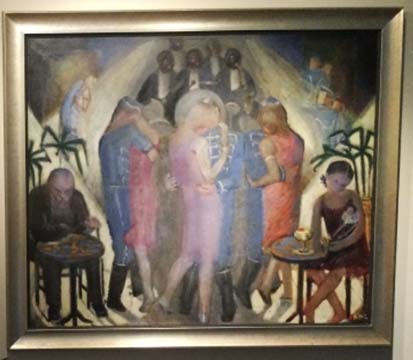

MARGRETE LEVY
"SOLDIER'S BALL"
OIL ON CANVAS, SIGNED
DANISH
EXHIBITED ROYAL CHARLOTTENBERG, COPENHAGEN 1929
38 X 45 INCHES

Margrete Levy 1881-1962 Levy was a Danish artist; she worked in Paris from 1905-1911. Levy was niece to the Danish master painter Kristian Zartmann. She married French author Louis Nicolai Levy in 1911. She applied for technical school at Charlotte Sode and Julie Meldahl's school before applying for admission to the Academy of Fine Arts for Women, where she studied at Viggo Johansen 1900-1902. In 1902 she traveled to Florence as a nanny for a Danish family, giving her the opportunity to study the old masters of the art collections. When she returned home, she continued her education in 1904-05 at Bertha and Dorph's painting school. In 1905, she traveled to Paris and taught at various drawing schools while studying the collections of the Louvre, especially Leonardo da Vinci, who inspired her for the symbolic painting Five Sisters , 1905, which she debuted at the Charlottenborg Spring Exhibition the following year. 1906-07 she was a student at the French Academy in Rome. With a few interruptions she exhibited at Charlottenborg's Spring Exhibition 1913-43, and on several occasions she also participated in Charlottenborg's Autumn Exhibition and the Artists' Autumn Exhibition. She had several personal exhibitions, including 1910 in Ole Haslunds Hus, 1919 and 1923 in Kunstforeningen, 1927 at Møntergården and 1945 in Alfred Andersen's Art Shop. She participated in several foreign exhibitions, for example Modern Danish Artists in Brighton, England 1912, and Exposition présentée par le Club international Féminin , Paris 1958. She was often represented at exhibitions reserved for women, for example Nine Painters in Admiral Gjeddes Gaard, in 1936 and Nordic Artists in Stockholm 1948. She participated in the Women's Artists Retrospective Exhibition in 1920, which was organized by the Women's Artists Society, on whose board she sat. Along with 18 other members, including Anna and Helga Ancher, Christine Swane, Elisabeth Neckelmann and, Olivia Holm-Møller, she exhibited at the Kunstforeningen in 1930. For the painting Three Sisters , she was awarded 1931 Carlson's Prize by the Academy. The painting shows both back to the old masters and to the new realists such as Niels Strøbek. Instead of the noble and royal figures of the past, she portrayed three middle-aged, life-marked, inward-looking and black-clad women who associate with mysterious figures such as norns and witches. In 1911 when she married Paris author Louis Levy whose works she came to illustrate. The Woman with the Tree Head , 1924, and Children's Rhyme, 1935. The couple had six children, and she managed to reconcile privacy and working life into a fruitful whole. Often the children modeled for her, and she has painted many portraits and pictures of children. Her first child inspired her to the children's book Fregnes's Diary from his birth to his 2 Year Birthday , 1914, which she herself wrote and illustrated. She also did illustrations for Charlotte Dorotha Biehl's letters, Emil Aarestrup's poems and Ingemann's morning and evening songs. Her paintings were personal, fabulous and ironic, for example Spring , 1915, depicting a small family on a picnic. The man walks in the front, whistling like a bird, while the wife behind pulls with two children, who pull her in each direction. The anemones surge through the lumbering tree trunks. The image is influenced by the decorative trends of the time. She was a contemporary artist, and she used both reinterpreted and she worked her way out of tradition. She also explored the many currents of the day, which included appears in the collage Fastelavn , 1918, which has adhered to parts of a fasteners rice. Sometimes the process may seem more important than the result, and she is constantly tumbling with form and color. For a time she was very busy with Tivoli as the motif world, which can be seen in, for example, Linen dancer in Tivoli and Morning in Tivoli , issue 1918. In addition to portraits of herself and her husband, she portrayed famous persons such as Else Johs.V. Jensen, 1912, the author Thit Jensen, c.1923, and the mystic Martinus. To emphasize the person's psyche, she used different styles and perceptions of color. Some works seem violent and disturbing, like the image of the author Poul Levin with family or Lunch , where the formal elements, such as picture plan and perspective, tip over completely and contribute to the impression of thumb. She made many trips, including to Switzerland 1904, Russia 1905 and Iceland 1936, but especially to Italy and France. She was awarded a number of scholarships, including Eibeschütz's Prize 1924 and Kristian Zahrtmann's Scholarship 1938. After her husband's death in 1940, she lived at the Lodz Solder Farm in Rørvig, where she cultivated her garden and was inspired by the surrounding nature. She was organized and hospitable, and her home formed the framework for meeting with other artists, including EnHenry Heerup and Svend Guttorm.
|
|